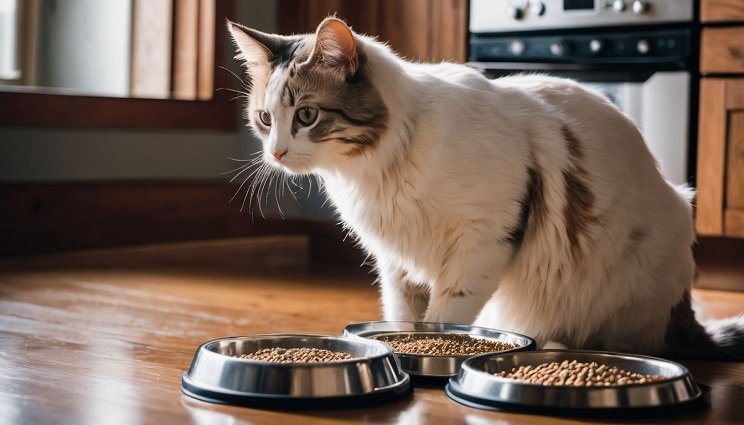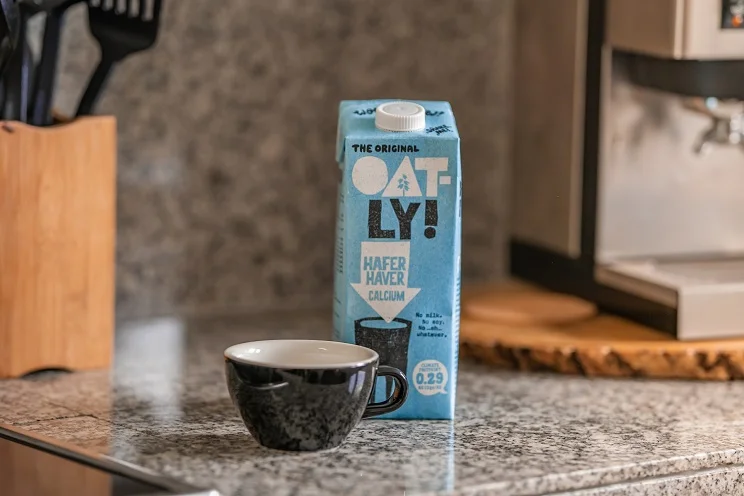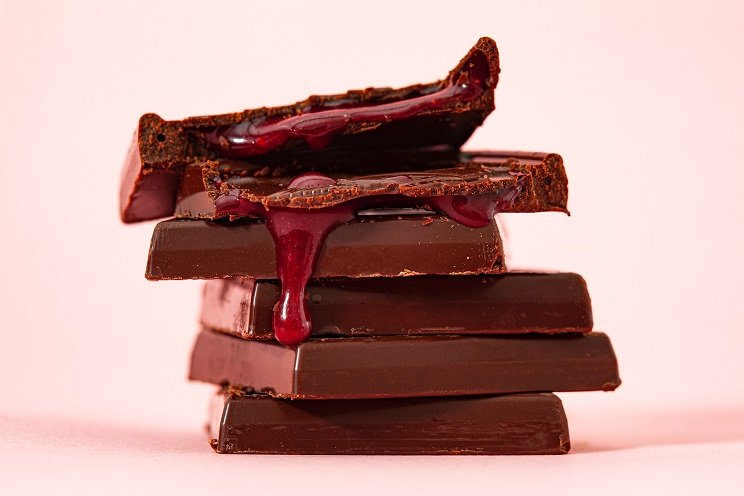Is your kitty chowing down on dry kibble or feasting on wet food? Recent studies show that wet food can keep your feline friend well-hydrated. This blog dives into the nitty-gritty of wet and dry cat food, helping you make the best pick for your purring pal.
Key Takeaways
- Wet cat food provides more moisture than dry food, which is good for your cat’s hydration and can prevent kidney problems.
- Dry cat food usually lasts longer and may be less expensive, but typically has more carbohydrates that could lead to weight gain if not managed properly.
- A mix of wet and dry foods might give your cat a well-rounded diet, with the benefits of hydration from wet food and dental health from dry kibble.
- Changing your cat’s diet should be done slowly over about a week to avoid upset stomachs.
What Are the Main Differences Between Wet and Dry Cat Food?
Wet cat food has higher moisture levels and is generally more palatable to cats, while dry cat food has a longer shelf life and can be beneficial for dental health. Each type of food also undergoes a different manufacturing process, resulting in varying nutrient content.
Moisture levels
Dry cat food typically has a low moisture content, around 10%. This makes it convenient and gives it a long shelf life. Cats eating dry food need to drink more water to stay hydrated.
Wet cat food is different because it’s packed with moisture, about 65% water content. This high level of hydration can help prevent kidney disease and support urinary tract health in cats.
It’s especially good for felines that might not drink enough water on their own.
Manufacturing process
Cat food makers mix high-moisture ingredients with meat to make wet cat food. They cook it and put it into cans. This keeps the food moist and rich in nutrients like proteins and fats.
Dry cat food is made by taking out water from the ingredients. This process, called extrusion, makes the food last longer on the shelf. Pet foods go through careful cooking to make sure they have everything a cat needs for good health.
Both processes aim for well-balanced diets that support cat health. Next, let’s look at how wet cat food can be good and bad for your pet.
Nutrient content
Wet cat food often packs more protein than its dry counterpart. It closely resembles the natural meat diet of felines in the wild. This high protein content supports healthy muscles and provides essential amino acids like taurine, vital for your cat’s heart and eyes.
Dry food typically has higher carbohydrates due to added grains and starches which help bind the kibble together during manufacturing. Cats can find energy in these carbs, but too much might lead to weight gain.
Look for dry foods that also include vitamins and minerals to ensure a balanced diet for your furry friend.
Pros and Cons of Wet Cat Food

Wet cat food helps with hydration and contains more protein and fat, but it also comes with a higher cost and shorter shelf life.
Helps with hydration
Wet cat food contains a high water content, which can help keep your cat hydrated. Dehydration in cats can lead to urinary tract problems and constipation, so providing wet food can prevent these issues.
Mixing the wet food with additional water also encourages more water intake, aiding in hydration and preventing potential health risks associated with dehydration.
Contains more protein and fat
Wet cat food contains higher levels of protein and fat compared to dry food. Many wet cat food formulations also have higher amounts of sodium and phosphorus than dry food. This makes wet cat food a good option for cats who need extra protein and fat in their diets, although it may not be suitable for all cats due to varying dietary needs.
Higher cost
Wet cat food generally costs more than dry cat food, making it less budget-friendly for pet owners. Despite its benefits, such as higher moisture content and better palatability, the increased cost of wet cat food is a significant factor to consider when choosing between the two options.
While dry cat food may be more economical, it’s essential to weigh this against other factors like your cat’s health and dietary needs when deciding which type of food to provide.
In terms of affordability, dry cat food offers a more cost-effective option for pet owners without compromising on nutritional value or quality. This makes it an attractive choice for those looking to balance their pets’ health with practicality and budget considerations.
Shorter shelf life and more maintenance
Wet cat food has a shorter shelf life due to its high water content. Once opened, it should be refrigerated and consumed within 24 hours to prevent spoilage. If not consumed immediately after being served, bacterial growth can occur, posing potential health concerns for cats.
Maintenance of wet cat food is higher as it needs to be refrigerated after opening and consumed within 24 hours to prevent spoilage. Bacterial growth may occur if not immediately consumed after being served with potential health concerns for cats.
Pros and Cons of Dry Cat Food
Dry cat food has a longer shelf life and can help with weight management due to its lower moisture content. However, it is generally less nutritious than wet cat food.
Longer shelf life
Dry cat food has a longer shelf life, making it convenient for pet owners. Once opened, canned cat food should be used within 24 hours to prevent spoilage. Freeze-dried cat food is also an option for a longer shelf life, although some changes in taste may occur.
This convenience makes dry cat food an attractive option for pet owners who want to ensure they always have a supply of pet food on hand.
Can help with weight management
While dry cat food has a longer shelf life, it can also help with weight management due to its lower calorie density. This makes it a suitable option for cats needing to shed some pounds.
The lower moisture content in dry food means that each bite contains fewer calories, making it easier for overweight or obese cats to lose weight without feeling deprived.
Additionally, the crunchiness of dry kibble promotes dental health by encouraging chewing and reducing plaque buildup, which is beneficial for overall oral hygiene. Furthermore, the higher fiber content in some dry foods can help cats feel fuller for longer periods, aiding in weight management.
Less nutritious
Dry cat food contains lower levels of protein, particularly animal protein, compared to most wet foods. The extrusion process used in making dry food can lead to reduced nutrient bioavailability due to the high heat involved, making it less nutritious than wet food.
These factors should be considered when determining the best diet for your feline friend.
The manufacturing method and nutrient content of dry cat food can make it less nutritionally beneficial than wet alternatives. It’s essential to evaluate these aspects carefully when choosing the most suitable diet for your cat’s health and well-being.
Which type of food is best for your cat?
The best food for your cat depends on its individual needs and preferences. Wet cat food can help with hydration, contains more protein and fat, but it’s costlier and has a shorter shelf life.
On the other hand, dry cat food has a longer shelf life and can aid in weight management, although it is less nutritious overall. Experts recommend a combination of wet and dry food to provide balanced nutrition for cats.
Remember that the choice between wet and dry cat food should be based on your cat’s specific health requirements, dietary preferences, and lifestyle factors rather than a one-size-fits-all approach.
How to transition your cat to a new type of food
Transition your cat to a new type of food gradually over 7 to 10 days. Mix the current and new food, then adjust the proportions over three days. This process takes time, patience, and tricks for success.
Conclusion
In conclusion, both wet and dry cat food have their advantages and disadvantages. The choice between the two depends on your cat’s individual needs, such as hydration, dental health, and dietary preferences.
Combining both types of food can offer a balanced approach by providing moisture from wet food and nutrients from dry food. Ultimately, it is essential to consult with your veterinarian to determine the best diet for your cat’s overall well-being.
FAQs
What’s the difference between wet and dry cat food?
Wet cat food is moist and comes in cans, while dry cat food has less water, comes in bags, and is crunchy.
Can wet or dry food help my cat lose weight?
Weight loss diets for cats can include both wet and dry foods. Wet food can be lower in calories (kcal/g), but it’s best to ask your vet what’s right for your pet.
Is one type of food better for my cat’s teeth?
Dry cat foods may help with oral health because their crunchy texture acts like a toothbrush to clean teeth, but always keep clean water available too.
Can changing from dry to wet food upset my cat’s stomach?
Switching your kitty from dry to canned foods can sometimes cause gastrointestinal upset, so change their diet slowly or ask your vet for advice on how to do it safely.




